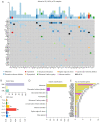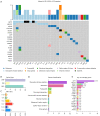Identification of genetic polymorphisms in unexplained recurrent spontaneous abortion based on whole exome sequencing
- PMID: 35722368
- PMCID: PMC9201170
- DOI: 10.21037/atm-22-2179
Identification of genetic polymorphisms in unexplained recurrent spontaneous abortion based on whole exome sequencing
Abstract
Background: The precise etiology of approximately 50% of patients with recurrent spontaneous abortion (RSA) is unclear, known as unexplained recurrent spontaneous abortion (URSA). This study identified the genetic polymorphisms in patients with URSA.
Methods: Genomic DNA was extracted from 30 couples with URSA and 9 couples with normal reproductive history for whole exome sequencing. Variations in annotation, filtering, and prediction of harmfulness and pathogenicity were examined. Furthermore, predictions of the effects of changes in protein structure, Sanger validation, and functional enrichment analyses were performed. The missense mutated genes with significant changes in protein function, and genes with mutations of premature stop, splice site, frameshift, and in-frame indel were selected as candidate mutated genes related to URSA.
Results: In 30 unrelated couples with URSA, 50%, 20%, and 30% had 2, 3, and more than 4 miscarriages, respectively. Totally, 971 maternal and 954 paternal mutations were found to be pathogenic or possibly pathogenic after preliminary filtering. Total variations were not associated with age nor the number of miscarriages. In 28 patients (involving 23 couples), 22 pathogenic or possibly pathogenic variants of 19 genes were found to be strongly associated with URSA, with an abnormality rate of 76.67%. Among these, 12 missense variants showed obvious changes in protein functions, including ANXA5 (c.949G>C; p.G317R), APP (c.1530G>C; p.K510N), DNMT1 (c.2626G>A; p.G876R), FN1 (c.5621T>C; p.M1874T), MSH2 (c.1168G>A; p.L390F), THBS1 (c.2099A>G; p.N700S), KDR (c.2440G>A; p.D814N), POLR2B (c.406G>T; p.G136C), ITGB1 (c.655T>C; p.Y219H), PLK1 (c.1210G>T; p.A404S), COL4A2 (c.4808 A>C; p.H1603P), and LAMA4 (c.3158A>G; p.D1053G). Six other genes with mutations of premature stop, splice site, frameshift, and in-frame indel were also identified, including BUB1B (c.1648C>T; p.R550*) and MMP2 (c.1462_1464delTTC; p.F488del) from the father, and mutations from mother and/or father including BPTF (c.396_398delGGA; p.E138 del and c.429_431GGA; p.E148del), MECP2 (c.21_23delCGC; p.A7del), LAMA2 (HGVS: NA; Exon: NA; SPLICE_SITE, DONOR), and SOX21 (c.640 _641insT; p. A214fs, c.644dupC; p. A215fs and c.644_645ins ACGCGTCTTCTTCCCGCAGTC; p. A215dup).
Conclusions: These pathogenic or potentially pathogenic mutated genes may be potential biomarkers for URSA and may play an auxiliary role in the treatment of URSA.
Keywords: Whole exome sequencing; genetic polymorphisms; signaling pathway; unexplained recurrent spontaneous abortion (URSA).
2022 Annals of Translational Medicine. All rights reserved.
Conflict of interest statement
Conflicts of Interest: All authors have completed the ICMJE uniform disclosure form (available at https://atm.amegroups.com/article/view/10.21037/atm-22-2179/coif). All authors report that this study was funded by the Science and Technology Research Project of Chongqing Education Commission (No. KJQN202100427) and the Young and Middle-Aged Medical Talents Project of Chongqing Municipal Health Commission/Chongqing Science and Technology Bureau (No. 2022GDRC001). The authors have no other conflicts of interest to declare.
Figures





Similar articles
-
Research hotspots and trends in unexplained recurrent spontaneous abortion (URSA) from 2014 to 2024: a bibliometric analysis.Front Med (Lausanne). 2025 May 14;12:1554875. doi: 10.3389/fmed.2025.1554875. eCollection 2025. Front Med (Lausanne). 2025. PMID: 40438372 Free PMC article.
-
The relationship between polymorphisms in the promoter region of Tim-3 and unexplained recurrent spontaneous abortion in Han Chinese women.Reprod Biol Endocrinol. 2013 Nov 11;11:104. doi: 10.1186/1477-7827-11-104. Reprod Biol Endocrinol. 2013. PMID: 24209883 Free PMC article.
-
[Study on association of functional polymorphisms in Foxp3 gene with the susceptibility to unexplained recurrent spontaneous abortion].Zhonghua Fu Chan Ke Za Zhi. 2011 Oct;46(10):763-8. Zhonghua Fu Chan Ke Za Zhi. 2011. PMID: 22321351 Chinese.
-
A missense variant in NCF1 is associated with susceptibility to unexplained recurrent spontaneous abortion.Open Life Sci. 2022 Nov 14;17(1):1443-1450. doi: 10.1515/biol-2022-0518. eCollection 2022. Open Life Sci. 2022. PMID: 36448060 Free PMC article.
-
The present and future of whole-exome sequencing in studying and treating human reproductive disorders.J Genet Genomics. 2018 Oct 20;45(10):517-525. doi: 10.1016/j.jgg.2018.08.004. Epub 2018 Oct 22. J Genet Genomics. 2018. PMID: 30391409 Review.
Cited by
-
Understanding recurrent pregnancy loss: recent advances on its etiology, clinical diagnosis, and management.Med Rev (2021). 2022 Dec 19;2(6):570-589. doi: 10.1515/mr-2022-0030. eCollection 2022 Dec. Med Rev (2021). 2022. PMID: 37724255 Free PMC article. Review.
-
Pathogenic variants of BUB1 and BUBR1 genes are not prioritized in screening tests of couples with aborted aneuploid fetuses.Mol Biol Res Commun. 2025;14(2):143-147. doi: 10.22099/mbrc.2024.51170.2037. Mol Biol Res Commun. 2025. PMID: 40028477 Free PMC article.
-
Integrated Analysis of WES and scRNA-Seq Data Reveals the Genetic Basis of Immune Dysregulation in Unexplained Recurrent Pregnancy Loss.J Clin Lab Anal. 2025 Mar;39(6):e70011. doi: 10.1002/jcla.70011. Epub 2025 Mar 11. J Clin Lab Anal. 2025. PMID: 40066928 Free PMC article.
-
Whole exome sequencing identifies a novel mutation in Annexin A4 that is associated with recurrent spontaneous abortion.Front Med (Lausanne). 2024 Sep 27;11:1462649. doi: 10.3389/fmed.2024.1462649. eCollection 2024. Front Med (Lausanne). 2024. PMID: 39399103 Free PMC article.
-
Predicting Infertility: How Genetic Variants in Oocyte Spindle Genes Affect Egg Quality.Adv Anat Embryol Cell Biol. 2024;238:1-22. doi: 10.1007/978-3-031-55163-5_1. Adv Anat Embryol Cell Biol. 2024. PMID: 39030352 Review.
References
LinkOut - more resources
Full Text Sources
Other Literature Sources
Miscellaneous
